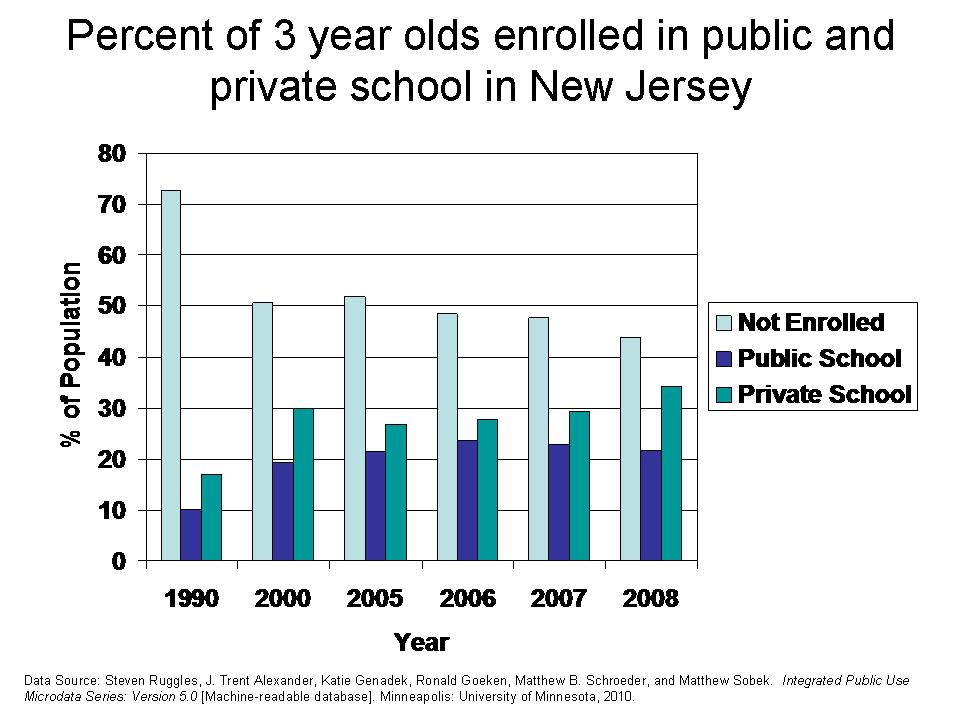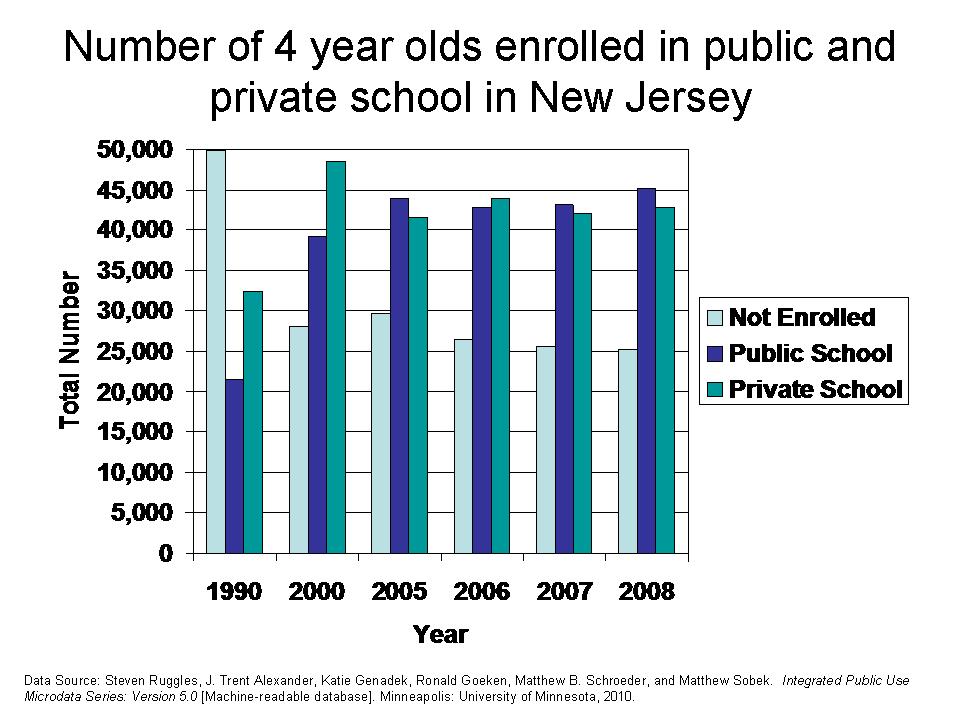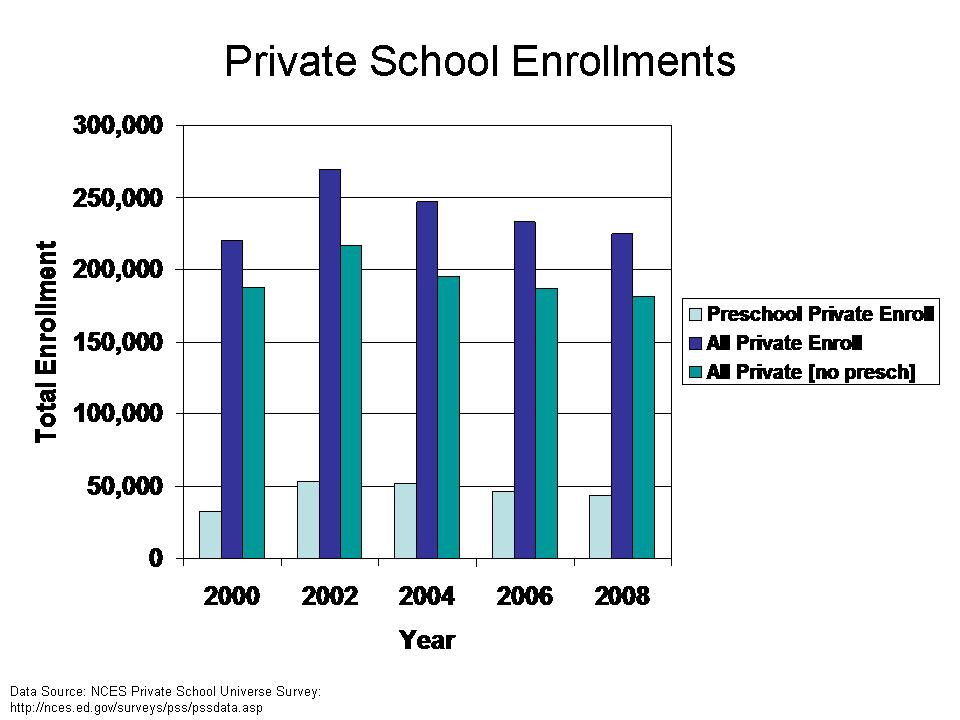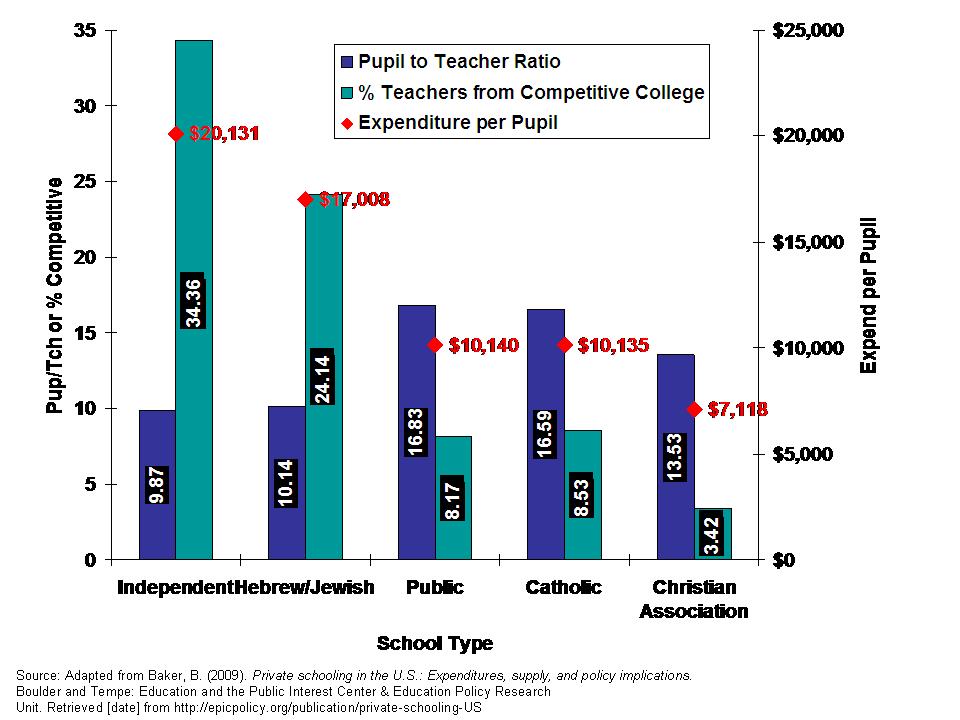There is little I find more enjoyable than boldly stated claims where the claims are entirely unsubstantiated… but where data are relatively accessible for testing those claims.
This week, the Governor’s Task Force on Privatization in New Jersey released their final report on the virtues of privatization for specific services. I took particular interest in the claims made about preschool in New Jersey. Preschool programs were expanded significantly with public support for both public and private programs for 3 and 4 year olds following the 1998 NJ Supreme Court ruling in Abbott v. Burke. For more information on the rulings and Abbott pre-school programs, see: http://www.edlawcenter.org/ELCPublic/AbbottPreschool/AbbottPreschoolProgram.htm
Here are the claims made in the privatization report:
•At the program’s inception, nearly 100 percent of students were served by providers in the private sector, many of which are women‐and minority‐owned businesses. Now, approximately 60 percent are served by private providers, as traditional districts have built preschools at great public expense and unfairly regulated their private‐sector competitors out of business.•There are currently two sets of state regulations governing pre‐k. The majority of private pre‐k providers are subject to Dept. of Children and Families (DCF) regulations, but private pre‐k providers working in the former Abbott districts and serving low‐income children in some other districts are subject to the regulation of the DOE and the respective districts themselves, effectively crowding out the private sector and driving up costs to the taxpayer without any documented benefit to the children they serve.
In this post, I’ll address two issues:
Second, I revisit some of my previous findings about private versus public school markets, cost and quality. The recommendation that follows from the above claims is that the state, instead of continuing to subsidize expensive Abbott preschool programs, should allow any private provider to participate without Abbott regulation. This, it is assumed, would dramatically reduce costs. Rather, this might reduce expenditures… and the quality of service along with it. Lower spending (not cost) private providers simply don’t and can’t offer what higher spending providers do. Cost assumes specific quality, and lower “cost” assumes that less can be spent for the same quality. In this case, quality is being ignored entirely (or assumed entirely unimportant). That is, the proposed plan of allowing any private provider to house “preschool” students would likely be the equivalent of subsidized “daycare” (minimally compliant with Dept. of Children and Families (DCF) regulations) and not actual “pre-school.”
Issue 1
For 3 year olds, from 1990 to 2000, both public and private enrollment increase, while non-enrollment decreases. Public and private enrollment then stay relatively steady, except for an apparent increase in private enrollment in 2008 (I’m not confident in this bump, having seen other odd jumps between 2007 and 2008 IPUMS data). In any case, it would not appear that public enrollment has continued to severely squeeze out the private market place, unless we were to assume that the private market would have absorbed the entirety of the reduction in non-enrollment. The lack of substantive shift from 2000 to 2008, with privates if anything, increasing their share, suggests that public subsidized have not led to the collapse of the private preschool market.
As an alternative, I explore the enrollment of private schools which provide pre-kindergarten programs statewide, using the National Center for Education Statistics Private School Universe Survey. Using this data set, we can determine whether the number of enrollment slots at the preschool level among private providers has declined, and whether the decline in private preschool enrollment has been greater than the decline in private school enrollment more generally. Note that much has been made of the “collapse” of private schooling in New Jersey in the context of the New Jersey Opportunity Scholarship Act.
This figure shows that private school enrollment generally has declined more than private preschool enrollment since 2000. Private preschool enrollment has remained relatively stagnant statewide from 2002 to 2008. No real collapse of private preschools evident here.
Issue 2
As I noted above, preschool might be defined in many different ways. On the one hand, we might wish to consider preschool to be any place that meets minimum health and safety guidelines for caring for children between the ages of 3 and 4. To me, that sounds more like daycare. Alternatively, preschool might actually involve specific curriculum and activities as well as training for personnel, etc. Obviously, these differences in definition can and likely do significantly influence the cost per child of offering the service. If I can hire high school graduates and rely heavily in parent volunteers, and use only minimally compliant physical space to supervise children at play – mix in story time – I can likely do things relatively cheaply. On the other hand, if I actually have to hire teachers who hold college degrees and provide a specific curriculum and have appropriate physical spaces in which to do those things, it’s likely going to get more expensive – publicly or privately provided. It’s not so much about whether it’s publicly or privately provided, but whether there are minimum expectations for what defines “preschool.”
The elementary and secondary private school market is highly stratified by price and quality, as I have discussed on many previous occasions. YOU GET WHAT YOU PAY FOR. Yeah… I know that clashes with the appealing logic that private providers always do more with less…. thwarting the “you get what you pay for” assumption… or even reversing it… ‘cuz private provides do so much more with so much less. But let’s look again at one of my favorite summaries – with a new presentation – of the private school market. Here’s the earlier version.
This figure lines up the national average (regionally cost adjusted for each regional cluster) a) per pupil spending, b) pupil to teacher ratios and c) percentage of teachers who attended competitive undergraduate colleges, for private schools by private school type. Public school expenditures sit right near the middle. The small group of Catholic schools in the national sample sit right along side public schools (the system of Catholic schools has evolved to look much like their public school counterparts over time). Independent schools spend nearly twice what public schools spend, have much smaller class sizes and have very high percentages of teachers who attended competitive undergraduate colleges. Hebrew and Jewish day schools lie about half way between the elite privates and public and Catholic schools. At the other end of the private school market are conservative christian schools, which spend much less per pupil than public or Catholic schools. They do have somewhat smaller class sizes, but have very poorly paid teachers, and have few if any teachers who attended competitive colleges. For more on these comparisons, see: https://schoolfinance101.wordpress.com/2010/02/20/stossel-coulson-misinformation-on-private-vs-public-school-costs/. In short, this figure shows that even in the k-12 marketplace, private providers are very diverse, some offering small class sizes and highly qualified teachers for a much higher price than public schools, and others offering much less.
We can certainly expect at least as much variation in the private preschool marketplace, if not one-heck-of-a-lot more, since many private daycare facilities require little or no formal training and no college degree for their employees.
As an aside, I was driving down Route 202 the other day west of Somerville Circle and noticed that they are putting in a Creme-de-la-Creme “daycare/preschool.” We had one around the corner from our house in Leawood, KS. I suspect that few of the Abbott preschool facilities built at such great expense compare favorably to a “Creme” facility – with waterpark (we’re talking slides, fountains), mini tennis court, indoor fish pond, tv studio, etc. (at least that’s what the one in Leawood had. I expect nothing less here?). I expect that many parents, having toured many other “less desirable” daycare and preschools, will decide that their child deserves the “Creme” lifestyle (I suspect that there are actually other options with better curriculum and perhaps better teachers in the area, but I have not had the occasion to research it). It’s just an extreme example of the diversity of the private preschool marketplace. I suspect the cost per pupil will far exceed that of the Abbott preschools (heck… it already exceeded $12k per year in Kansas several years ago).
To summarize, the Task Force report on privatization makes bold claims about Abbott preschool programs crowding out, and decimating private preschool programs, many run by women and minority business owners. But the Task Force report does not bother to substantiate a) that private preschools have actually suffered, or b) that any, if they had suffered, were actually owned and operated by women or minorities. The only “evidence” the report has to offer is the undocumented claim that 100% of kids were in private programs and now only 60% are. Where does that come from? What the heck is that? 100% of who? 60% of what?
Further, the Task Force report is willing to assume that warehousing 3 and 4 year olds under the supervision of high school graduates in physical spaces and with supervision ratios compliant with DCF regulations is sufficient for low-income and minority children… or rather… that it is the lower cost option with equivalent quality to Abbott pre-school programs (public or publicly regulated private). It is critically important that we acknowledge the difference in the quality or even type of service received at different price points. Like the private K-12 market, the private preschool market varies widely, and spending much less generally means getting much less.
=====
See also, the Abbott 5th year report: http://edlawcenter.org/ELCPublic/Publications/PDF/PreschoolFifthYearReport.pdf
Manual for Child Care Centers from DCF in NJ: http://www.nj.gov/dcf/divisions/licensing/CCCmanual.pdf
Can’t forget this:






One thought on “Another “You Cannot be Serious!” The demise of private sector preschool in New Jersey?”
Comments are closed.